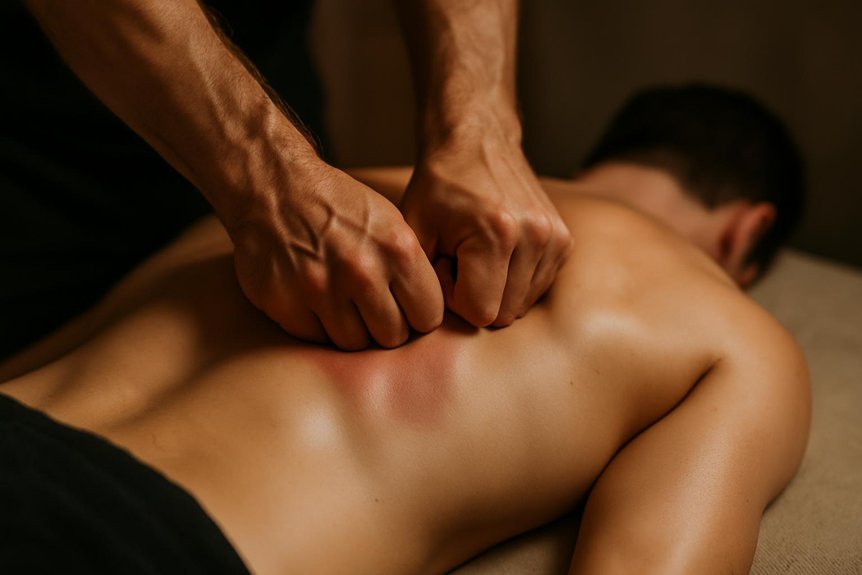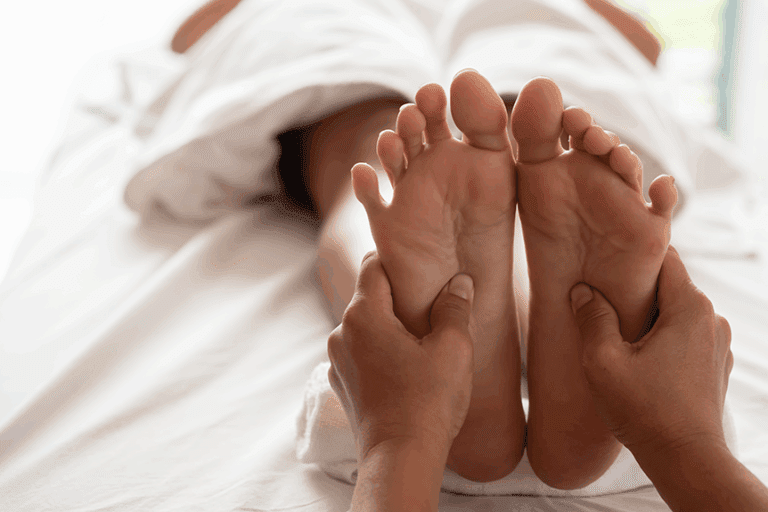It can cause injury when pressure is excessive, poorly directed, or applied over inflamed or neurologically sensitive areas. Risks include myofascial microtears, nerve irritation, and bruising, especially near bony borders. Red flags are sharp or escalating pain, numbness, tingling, dizziness, or bruising. Soreness beyond 72 hours suggests over-treatment. Clients with acute inflammation, recent surgery, bleeding risks, or neuropathy need modification or avoidance. Skilled therapists mitigate risk with graded pressure, communication, and monitoring. The following clarifies signs, precautions, and safer options.
Understanding What It Involves

Although often conflated with “strong” massage, deep tissue massage is defined by technique rather than pressure. It targets myofascial adhesions and dysfunctional tone within deeper layers by using slow, specific strokes and sustained, melting compressions aligned with fibre direction. Therapists at Spa & Massage apply incremental load, pausing to allow viscoelastic tissues to yield without forcing.
Assessment precedes treatment: palpation identifies trigger points, restricted glide, and protective guarding.
Sessions typically combine forearm stripping, precise thumb or elbow ischemic compression, and myofascial release to restore glide, improve range, and modulate nociception via mechanoreceptor input.
Breathing cues facilitate parasympathetic shift and soften guarding.
In our London clinics, therapists calibrate depth through client feedback, tissue response, and observable relaxation markers, tailoring sequences to individual patterns and goals.
This technique can be particularly effective for addressing myofascial adhesions, as it uses deep, sustained pressure to release chronic tension and improve overall mobility.
Potential Risks and When Injury Can Occur
It can become harmful when pressure exceeds tissue tolerance, particularly over inflamed structures, recent injuries, anticoagulated clients, or areas with neuropathic symptoms.
Red flags during treatment include sharp or escalating pain, numbness or tingling, dizziness, unexpected bruising, or loss of range of motion—signals to stop, reassess technique, and adjust pressure or positioning.
At Spa & Massage, therapists monitor these indicators continuously and modify or cease treatment to prevent tissue damage and neurovascular irritation.
When Pressure Becomes Harmful
When excessive or poorly directed pressure is applied during deep tissue work, the risk of tissue damage increases, particularly in areas with superficial nerves, fragile vasculature, or recent injury. Harm most often manifests as myofascial microtears, nerve irritation (paresthesia, shooting pain), or vascular bruising.
High-load compression at bony borders—the rib cage, anterior neck, fibular head, or medial elbow—raises risk. So do anticoagulant use, diabetes-related neuropathy, inflammatory flares, or post-acute trauma.
From Spa & Massage’s perspective, safety is governed by tissue response: therapeutic intensity feels deep yet breathable, not sharp, burning, or electric. Our therapists modulate pressure gradually, shorten holds on sensitive structures, and prefer slow, angled strokes over static force.
In London clinics, we map client history and palpate for tone, temperature, and tenderness, adjusting technique to protect vulnerable tissues.
Red Flags During Treatment
Therapeutic intensity must remain tolerable and breathable; deviations signal risk. Red flags include sharp, electric, or escalating pain; breath-holding; protective muscle guarding; radiating symptoms into a limb; numbness or pins-and-needles; joint or rib pain; and sudden headache, dizziness, or visual changes.
Local warmth, swelling, or marked bruising may indicate excessive tissue load. Post-session, pain that peaks after 24–48 hours and limits function suggests overpressure.
At Spa & Massage in London, therapists monitor tissue response, adjust depth gradually, and pause if communication falters. They avoid strong pressure over recent injury, bony prominences, varicose veins, or areas with altered sensation.
Clients on anticoagulants, with clotting disorders, diabetes-related neuropathy, or osteoporosis warrant conservative dosing. If any red flag emerges, technique is modified immediately, or the session is halted and medical review advised.
Who Should Avoid or Modify Deep Tissue Techniques
Certain clients should avoid or modify it due to contraindications such as acute inflammation, active infection, uncontrolled hypertension, coagulopathy/anticoagulant use, recent surgery, fractures, severe osteoporosis, neuropathic pain syndromes, or pregnancy complications.
Pressure should be adapted in the presence of bruising, hematoma, edema, peripheral neuropathy, varicose veins, tissue fragility from corticosteroid use, and during early-stage softtissue healing.
At Spa & Massage, therapists screen for these risks and adjust technique, depth, and pacing accordingly to prioritise safety and therapeutic outcomes.
Contraindications and Risks
It should be adjusted—or avoided altogether—to protect client safety. Contraindications include acute inflammation, fever, uncontrolled hypertension, severe osteoporosis, active infection, recent surgery or fractures, deep vein thrombosis, bleeding disorders, anticoagulant use, and advanced peripheral neuropathy.
Pregnancy requires modified techniques; oncology and diabetes care demand medical guidance. Local contraindications include open wounds, bruising, rashes, varicosities, and areas of numbness or severe pain.
Risks, though uncommon with skilled application, include exacerbation of inflammation, hematoma, neurapraxia, post-treatment soreness beyond 48 hours, and vasovagal responses.
At Spa & Massage, therapists screen with a detailed health intake, adapt pressure gradients, avoid end-range pain, and obtain consent for focused work. They coordinate with medical advice when indicated and document tissue response, ensuring comfort-led, clinically responsible care.
When to Adapt Pressure
Building on contraindications and risks, pressure must be titrated to tissue tolerance and medical status to prevent harm. Individuals with acute injury, active inflammation, uncontrolled hypertension, anticoagulant use, peripheral neuropathy, osteoporosis, connective tissue disorders, or recent surgery require lighter, slower work and vigilant feedback.
Pregnancy, diabetes with neuropathy, and fibromyalgia also warrant moderated depth and shorter durations. Bruising history, steroid use, or fragile skin signals reduced shear and compression.
Spa & Massage therapists apply graded exposure—warming tissues, testing pressure, and pausing at protective muscle guarding. They avoid end-range loading over bony prominences, varicosities, or lymphatic-compromised areas, and defer deep techniques within 72 hours of strenuous training.
Consent is revisited continuously; discomfort must remain tolerable and reversible within 24 hours. When in doubt, they prioritise comfort, circulation, and breath-led pacing.
How Our Therapists Minimise Risk at Spa & Massage
Why do adverse events remain uncommon at Spa & Massage? Their therapists apply clinically reasoned screening, calibrated pressure, and continuous feedback. Pre-session intake identifies red flags—anticoagulants, vascular disease, recent injury, pregnancy, neuropathy—so techniques and depths are adjusted or deferred.
Palpation is methodical: slow warming, then graded engagement of fascia and muscle, avoiding end-range compression over bony prominences, lymph nodes, or varicosities.
They use hypoallergenic oils in modest amounts to control glide, enabling precise, non-shearing strokes. Time under tension is limited; deep work is distributed across regions to prevent cumulative load.
Communication is explicit: firm should feel therapeutic, never sharp, burning, or dizzying. Documentation guides progression between visits.
Clinicians are trained to UK standards and receive ongoing supervision, ensuring consistent, safe practice across all London locations.
Signs of Over-Treatment and What to Do Next
Although post-massage soreness for 24–48 hours can be normal, several findings suggest over-treatment: focal, sharp pain rather than dull ache; bruising or petechiae; lingering soreness beyond 72 hours; reduced range of motion or protective guarding; nerve-type symptoms (tingling, numbness, radiating pain); headache, dizziness, nausea, or unusual fatigue; and swelling or warmth over treated areas.
If these arise, intervention should be prompt. They advise pausing deep tissue work, monitoring symptoms, and seeking clinical assessment if red flags persist or escalate.
Gentle movement, hydration, and relative rest help, but severe or progressive neurologic signs warrant urgent medical review.
At Spa & Massage, therapists document findings, adjust pressure, and revise goals collaboratively. Clients are encouraged to report specifics—onset, location, intensity—so sessions can be retuned for safety and comfort.
Safe Alternatives and Aftercare for Sensitive Clients
When sensitivity or a history of over-treatment is identified, therapists should pivot to lower-load options with clear parameters and monitoring.
At Spa & Massage, clinicians prioritise gentle, circulation-focused work: light Swedish strokes, myofascial gliding without sustained compression, targeted mobilisations, and breath-synchronised holds.
For pain modulation, therapists may employ shorter, well-tolerated trigger point contacts (5–10 seconds) and stop rules using a 0–10 comfort scale (ceiling 3–4/10).
Adjuncts include warm compresses, hypoallergenic oils, and aromatherapy blends titrated to minimal effective concentrations.
Aftercare is structured: hydration guidance, 24–48 hours of load management, contrast hydrotherapy for swelling risk, and paced mobility (pain-free ranges only).
Clients receive red-flag education and a review at 48–72 hours.
Many choose a progressive plan—graduated pressure, longer intervals, and outcome tracking—to restore confidence safely.
Conclusion
In conclusion, this massage therapy can be both powerful and safe when delivered with appropriate assessment, staged pressure, and active communication. While transient soreness is common, true injury is uncommon with skilled application. Significantly, up to 10–15% of clients report short-lived post-massage discomfort, whereas serious adverse events are rare in clinical literature. Spa & Massage therapists mitigate risk by screening for contraindications, adapting techniques, and guiding aftercare, ensuring therapeutic benefit while protecting clients with complex pain profiles or medical conditions.



